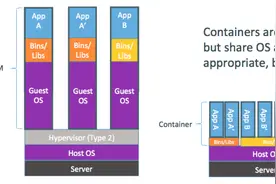无论选择是什么,Spring 都能容纳这两种风格,甚至可以将它们混合在一起。值得指出的是,通过它的 JAVA 配置选项,Spring 允许注解以一种非入侵的方式使用,不触碰目标组件源码和那些工具,所有的配置风格由 Spring 工具套件支持。
基于注解的配置提供了一种 XML 设置的可替代方式,它依赖于字节码元数据来连接组件,而不是用尖括号声明的方式。代替使用 XML 来描述 bean 连接,开发者通过将注解使用在相关的类,方法或字段声明中,将配置移动到了组件类本身的内部。正如在“Example: The
RequiredAnnotationBeanPostProcessor”那节提到的那样,使用BeanPostProcessor与注解结合是扩展 Spring IoC 容器的的常见方法。例如,Spring 2.0 引入了@Required注解来执行需要的属性的可能性。Spring 2.5 使以同样地通用方法来驱动 Spring 的依赖注入变为可能。本质上来说,@Autowired提供了如 3.4.5 小节描述的同样的能力。“Autowiring collaborators”但更细粒度的控制和更广的应用性。Spring 2.5 也添加对 JSR-250 注解的支持,例如,@PostConstruct和@PreDestroy
。Spring 3.0 添加了对 JSR-330,包含在javax.inject包内的注解(Java 的依赖注入)的支持,例如@Inject和@Named。关于这些注解的细节可以在相关的小节找到。
注解注入在 XML 注入之前进行,因此对于通过两种方法进行组装的属性后者的配置会覆盖前者。
跟以前一样,你可以作为单独的 bean 定义来注册它们,但也可以通过在一个基于 XML 的 Spring 配置(注入包含上下文命名空间)中包含下面的标签来隐式的注册它们:
<?xml version="1.0" encoding="UTF-8"?>
<beans xmlns="http://www.springframework.org/schema/beans"
xmlns:xsi="http://www.w3.org/2001/XMLSchema-instance"
xmlns:context="http://www.springframework.org/schema/context"
xsi:schemaLocation="http://www.springframework.org/schema/beans
http://www.springframework.org/schema/beans/spring-beans.xsd
http://www.springframework.org/schema/context
http://www.springframework.org/schema/context/spring-context.xsd">
context:annotation-config/
</beans>
(隐式注册的后处理器包括
AutowiredAnnotationBeanPostProcessor,
CommonAnnotationBeanPostProcessor,
PersistenceAnnotationBeanPostProcessor和前面提到的
RequiredAnnotationBeanPostProcessor。)
<
context:annotation-config/>仅在定义它的同样的应用上下文中寻找注解的 beans。这意味着,如果你在一个为DispatcherServlet服务的WebApplicationContext中放置了<context:annotation-config/>,它只能在你的控制器中寻找@Autowired注解的 beans,而不是在你的服务层中。更多信息请看 18.2 小节,“The DispatcherServlet”。
@Required注解应用到 bean 属性的 setter 方法上,例子如下:
public class SimpleMovieLister {
private MovieFinder movieFinder;
@Required
public void setMovieFinder(MovieFinder movieFinder) {
this.movieFinder = movieFinder;
}
// ...
}
这个注解仅仅是表明受影响的 bean 属性必须在配置时通过显式的 bean 定义或自动组装填充。如果受影响的 bean 属性没有填充,容器会抛出一个异常,这允许及早明确的失败,避免NullPointerExceptions或后面出现类似的情况。仍然建议你在 bean 类本身加入断言,例如,加入到初始化方法中。这样做可以强制这些需要的引用和值,甚至是你在容器外部使用这个类的时候。
2 @Autowired
===========================================================================
在下面的例子中 JSR 330 的@Inject注解可以用来代替 Spring 的@Autowired注解。
你可以将@Autowired注解应用到构造函数上。
public class MovieRecommender {
private final CustomerPreferenceDao customerPreferenceDao;
@Autowired
public MovieRecommender(CustomerPreferenceDao customerPreferenceDao) {
this.customerPreferenceDao = customerPreferenceDao;
}
// ...
}
从 Spring 框架 4.3 起,如果目标 bena 仅定义了一个构造函数,那么@Autowired注解的构造函数不再是必要的。如果一些构造函数是可获得的,至少有一个必须要加上注解,以便于告诉容器使用哪一个。
正如预料的那样,你也可以将@Autowired注解应用到“传统的”setter 方法上:
public class SimpleMovieLister {
private MovieFinder movieFinder;
@Autowired
public void setMovieFinder(MovieFinder movieFinder) {
this.movieFinder = movieFinder;
}
// ...
}
你也可以应用注解到具有任何名字和/或多个参数的方法上:
public class MovieRecommender {
private MovieCatalog movieCatalog;
private CustomerPreferenceDao customerPreferenceDao;
@Autowired
public void prepare(MovieCatalog movieCatalog,
CustomerPreferenceDao customerPreferenceDao) {
this.movieCatalog = movieCatalog;
this.customerPreferenceDao = customerPreferenceDao;
}
// ...
}
你也可以应用@Autowired到字段上,甚至可以与构造函数混合用:
public class MovieRecommender {
private final CustomerPreferenceDao customerPreferenceDao;
@Autowired
private MovieCatalog movieCatalog;
@Autowired
public MovieRecommender(CustomerPreferenceDao customerPreferenceDao) {
this.customerPreferenceDao = customerPreferenceDao;
}
// ...
}
通过给带有数组的字段或方法添加@Autowired注解,也可以从ApplicationContext中提供一组特定类型的 bean:
public class MovieRecommender {
@Autowired
private MovieCatalog[] movieCatalogs;
// ...
}
同样也可以应用到具有同一类型的集合上:
public class MovieRecommender {
private Set<MovieCatalog> movieCatalogs;
@Autowired
public void setMovieCatalogs(Set<MovieCatalog> movieCatalogs) {
this.movieCatalogs = movieCatalogs;
}
// ...
}
如果你希望数组或列表中的项按指定顺序排序,你的 bean 可以实现
org.springframework.core.Ordered接口,或使用@Order或标准@Priority注解。
只要期望的 key 是String,那么类型化的 Maps 就可以自动组装。Map 的值将包含所有期望类型的 beans,key 将包含对应的 bean 名字:
public class MovieRecommender {
private Map<String, MovieCatalog> movieCatalogs;
@Autowired
public void setMovieCatalogs(Map<String, MovieCatalog> movieCatalogs) {
this.movieCatalogs = movieCatalogs;
}
// ...
}
默认情况下,当没有候选 beans 可获得时,自动组装会失败;默认的行为是将注解的方法,构造函数和字段看作指明了需要的依赖。这个行为也可以通过下面的方式去改变。
public class SimpleMovieLister {
private MovieFinder movieFinder;
@Autowired(required=false)
public void setMovieFinder(MovieFinder movieFinder) {
this.movieFinder = movieFinder;
}
// ...
}
每个类只有一个构造函数可以标记为必需的,但可以注解多个非必需的构造函数。在这种情况下,会考虑这些候选者中的每一个,Spring 使用最贪婪的构造函数,即依赖最满足的构造函数,具有最大数目的参数。
建议在@Required注解之上使用@Autowired的required特性。required特性表明这个属性自动装配是不需要的,如果这个属性不能被自动装配,它会被忽略。另一方面@Required是更强大的,在它强制这个属性被任何容器支持的 bean 设置。如果没有值注入,会抛出对应的异常。
你也可以对那些已知的具有可解析依赖的接口使用@Autowired:BeanFactory,ApplicationContext,Environment, ResourceLoader,ApplicationEventPublisher和MessageSource。这些接口和它们的扩展接口,例如
ConfigurableApplicationContext或ResourcePatternResolver,可以自动解析,不需要特别的设置。
public class MovieRecommender {
@Autowired
private ApplicationContext context;
public MovieRecommender() {
}
// ...
}
@Autowired、@Inject、@Resource和@Value都是通过 Spring 的BeanPostProcessor实现处理的,这反过来意味着,你不能在自己的BeanPostProcessor或BeanFactoryPostProcessor中使用这些注解。
这些类型必须显式通过 XML 或使用 Spring 的@Bean方法来装配。
3 用 @Primary 微调基于注解的自动装配
因为根据类型的自动装配可能会导致多个候选目标,所以在选择过程中进行更多的控制经常是有必要的。一种方式通过 Spring 的@Primary注解来完成。当有个多个候选 bean 要组装到一个单值的依赖时,@Primary表明指定的 bean 应该具有更高的优先级。如果确定一个’primary’ bean 位于候选目标中间,它将是那个自动装配的值。
假设我们具有如下配置,将firstMovieCatalog定义为主要的MovieCatalog。
@Configuration
public class MovieConfiguration {
@Bean
@Primary
public MovieCatalog firstMovieCatalog() { ... }
@Bean
public MovieCatalog secondMovieCatalog() { ... }
// ...
}
根据这样的配置,下面的MovieRecommender将用firstMovieCatalog进行自动装配。
public class MovieRecommender {
@Autowired
private MovieCatalog movieCatalog;
// ...
}
对应的 bean 定义如下:
<?xml version="1.0" encoding="UTF-8"?>
<beans xmlns="http://www.springframework.org/schema/beans"
xmlns:xsi="http://www.w3.org/2001/XMLSchema-instance"
xmlns:context="http://www.springframework.org/schema/context"
xsi:schemaLocation="http://www.springframework.org/schema/beans
http://www.springframework.org/schema/beans/spring-beans.xsd
http://www.springframework.org/schema/context
http://www.springframework.org/schema/context/spring-context.xsd">
context:annotation-config/
<bean class="example.SimpleMovieCatalog" primary="true">
</bean>
<bean class="example.SimpleMovieCatalog">
</bean>
<bean id="movieRecommender" class="example.MovieRecommender"/>
</beans>
当有多个实例需要确定一个主要的候选对象时,@Primary是一种按类型自动装配的有效方式。当需要在选择过程中进行更多的控制时,可以使用 Spring 的@Qualifier注解。为了给每个选择一个特定的 bean,你可以将限定符的值与特定的参数联系在一起,减少类型匹配集合。在最简单的情况下,这是一个纯描述性值:
public class MovieRecommender {
@Autowired
@Qualifier("main")
private MovieCatalog movieCatalog;
// ...
}
@Qualifier注解也可以指定单个构造函数参数或方法参数:
public class MovieRecommender {
private MovieCatalog movieCatalog;
private CustomerPreferenceDao customerPreferenceDao;
@Autowired
public void prepare(@Qualifier("main")MovieCatalog movieCatalog,
CustomerPreferenceDao customerPreferenceDao) {
this.movieCatalog = movieCatalog;
this.customerPreferenceDao = customerPreferenceDao;
}
// ...
}
对应的 bean 定义如下。限定符值为”main”的 bean 被组装到有相同值的构造函数参数中。
<?xml version="1.0" encoding="UTF-8"?>
<beans xmlns="http://www.springframework.org/schema/beans"
xmlns:xsi="http://www.w3.org/2001/XMLSchema-instance"
xmlns:context="http://www.springframework.org/schema/context"
xsi:schemaLocation="http://www.springframework.org/schema/beans
http://www.springframework.org/schema/beans/spring-beans.xsd
http://www.springframework.org/schema/context
http://www.springframework.org/schema/context/spring-context.xsd">
context:annotation-config/
<bean class="example.SimpleMovieCatalog">
<qualifier value="main"/>
</bean
<bean class="example.SimpleMovieCatalog">
<qualifier value="action"/>
</bean>
<bean id="movieRecommender" class="example.MovieRecommender"/>
</beans>
对于回退匹配,bean 名字被认为是默认的限定符值。因此你可以定义一个 id 为main的 bean 来代替内嵌的限定符元素,会有同样的匹配结果。然而,尽管你可以使用这个约定根据名字引用特定的 beans,但是@Autowired从根本上来讲是使用可选的语义限定符来进行类型驱动注入的。这意味着限定符的值,即使回退到 bean 名称,总是缩小语义类型匹配的集合;它们没有从语义上将一个引用表达为一个唯一的 bean id。好的限定符值是”main”或”EMEA”或”persistent”,表达一个特定组件的性质,这个组件是独立于 bean id的,即使前面例子中像这个 bean 一样的匿名 bean 会自动生成 id。
正如前面讨论的那样,限定符也可以应用到类型结合上,例如,Set<MovieCatalog>。在这个例子中,根据声明的限定符匹配的所有 beans 作为一个集合进行注入。这意味着限定符不必是唯一的;它们只是构成过滤标准。例如,你可以定义多个具有同样限定符值”action”的MovieCatalog,所有的这些都将注入到带有注解@Qualifier("action")的Set<MovieCatalog>中。
如果你想通过名字表达注解驱动的注入,不要主要使用@Autowired,虽然在技术上能通过@Qualifier值引用一个 bean 名字。作为可替代产品,可以使用 JSR-250 @Resource注解,它在语义上被定义为通过组件唯一的名字来识别特定的目标组件,声明的类型与匹配过程无关。@Autowired有不同的语义:通过类型选择候选 beans,特定的String限定符值被认为只在类型选择的候选目标中,例如,在那些标记为具有相同限定符标签的 beans 中匹配一个”account”限定符。
对于那些本身定义在集合/映射或数组类型中的 beans 来说,@Resource是一个很好的解决方案,适用于特定的集合或通过唯一名字区分的数组 bean。也就是说,自 Spring 4.3 起,集合/映射和数组类型中也可以通过 Spring 的@Autowired类型匹配算法进行匹配,只要元素类型信息在@Bean中保留,返回类型签名或集合继承体系。在这种情况下,限定符值可以用来在相同类型的集合中选择,正如在前一段中概括的那样。
自 Spring 4.3 起,@Autowired也考虑自引用注入,例如,引用返回当前注入的 bean。注意自注入是备用;普通对其它组件的依赖关系总是优先的。在这个意义上,自引用不参与普通的候选目标选择,因此尤其是从不是主要的;恰恰相反,它们最终总是最低的优先级。在实践中,自引用只是作为最后的手段,例如,通过 bean 的事务代理调用同一实例的其它方法:在考虑抽出受影响的方法来分隔代理 bean 的场景中。或者,使用@Resource通过它的唯一名字可能得到一个返回当前 bean 的代理。
@Autowired可以应用到字段,构造函数和多参数方法上,允许通过限定符注解在参数层面上缩减候选目标。相比之下,@Resource仅支持字段和 bean 属性的带有单个参数的 setter 方法。因此,如果你的注入目标是一个构造函数或一个多参数的方法,坚持使用限定符。
你可以创建自己的定制限定符注解。简单定义一个注解,在你自己的定义中提供@Qualifier注解:
@Target({ElementType.FIELD, ElementType.PARAMETER})
@Retention(RetentionPolicy.RUNTIME)
@Qualifier
public @interface Genre {
String value();
}
然后你可以在自动装配的字段和参数上提供定制的限定符:
public class MovieRecommender {
@Autowired
@Genre("Action")
private MovieCatalog actionCatalog;
private MovieCatalog comedyCatalog;
@Autowired
public void setComedyCatalog(@Genre("Comedy") MovieCatalog comedyCatalog) {
this.comedyCatalog = comedyCatalog;
}
// ...
}
接下来,提供候选 bean 定义的信息。你可以添加<qualifier/>标记作为<bean/>标记的子元素,然后指定匹配你的定制限定符注解的类型和值。类型用来匹配注解的全限定类名称。或者,如果没有名称冲突的风险,为了方便,你可以使用简写的类名称。下面的例子证实了这些方法。
<?xml version="1.0" encoding="UTF-8"?>
<beans xmlns="http://www.springframework.org/schema/beans"
xmlns:xsi="http://www.w3.org/2001/XMLSchema-instance"
xmlns:context="http://www.springframework.org/schema/context"
xsi:schemaLocation="http://www.springframework.org/schema/beans
http://www.springframework.org/schema/beans/spring-beans.xsd
http://www.springframework.org/schema/context
http://www.springframework.org/schema/context/spring-context.xsd">
context:annotation-config/
<bean class="example.SimpleMovieCatalog">
<qualifier type="Genre" value="Action"/>
</bean>
<bean class="example.SimpleMovieCatalog">
<qualifier type="example.Genre" value="Comedy"/>
</bean>
<bean id="movieRecommender" class="example.MovieRecommender"/>
</beans>
在 3.10 小节,“类路径扫描和管理组件”中,你将看到一个基于注解的替代方法,在 XML 中提供限定符元数据。特别地,看 3.10.8 小节,“用注解提供限定符元数据”。
在某些情况下,使用没有值的注解就是足够的。当注解为了通用的目的时,这是非常有用的,可以应用到跨几个不同类型的依赖上。例如,当网络不可用时,你可以提供一个要搜索的离线目录。首先定义一个简单的注解:
@Target({ElementType.FIELD, ElementType.PARAMETER})
@Retention(RetentionPolicy.RUNTIME)
@Qualifier
public @interface Offline {
}
然后将注解添加到要自动装配的字段或属性上:
public class MovieRecommender {
@Autowired
@Offline
private MovieCatalog offlineCatalog;
// ...
}
现在 bean 定义只需要一个限定符类型:
<bean class="example.SimpleMovieCatalog">
<qualifier type="Offline"/>
</bean>
你也可以定义接收命名属性之外的定制限定符注解或代替简单的值属性。如果要注入的字段或参数指定了多个属性值,bean 定义必须匹配所有的属性值才会被认为是一个可自动装配的候选目标。作为一个例子,考虑下面的注解定义:
@Target({ElementType.FIELD, ElementType.PARAMETER})
@Retention(RetentionPolicy.RUNTIME)
@Qualifier
public @interface MovieQualifier {
String genre();
Format format();
}
这种情况下Format是枚举类型:
public enum Format {
VHS, DVD, BLURAY
}
要自动装配的字段使用定制限定符进行注解,并且包含了两个属性值:genre和format。
public class MovieRecommender {
@Autowired







